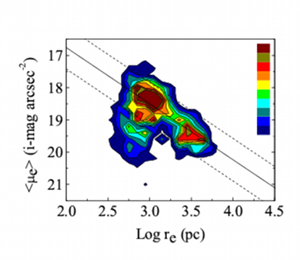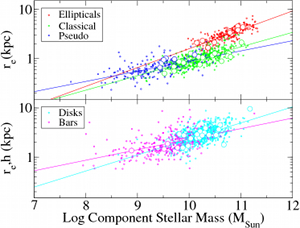 |
|
Fig. 1:
Massive galaxies have a variety of features which are witnesses of their
formation and evolutionary histories. This figure shows some of the SDSS
galaxies included in the new MPA study. Elliptical galaxies are in the top row,
followed by disc galaxies with classical bulges, disc galaxies with
pseudo-bulges and finally bulgeless galaxies in the bottom row.
|
 |
 |
|
Fig. 2:
Example of a result from BUDDA, the software used to measure the
structural properties of the different galaxy components, partially developed at
MPA. The SDSS galaxy image is at the top left panel, while the corresponding
best fit model is at the top right panel. The solid horizontal line in the
former denotes a length of 5 kpc at the galaxy distance. The image in the bottom
left panel is a residual image, where the model image is subtracted from the
original galaxy image, providing a finer perception of sub-structures such as
spiral arms. Finally, the surface brightness radial profiles of the galaxy image
(dashed line), the model (black solid line) and the individual galaxy components
(bulge in red, bar in green and disc in blue) are shown in the bottom right
corner. They attest the good quality of the fit, meaning that the decomposition
of the galaxy into its main components, a sort of galaxy dissection, was
successfull.
|
 |
 |
|
Fig. 3:
Relation between bulge effective surface brightness and effective
radius. Classical bulges obey the relation set by elliptical galaxies (the area
between the two dashed lines in the figure), but pseudo-bulges fall off the
relation, below the lower dashed line.
|
 |
 |
|
Fig. 4:
Relation between the sizes and stellar masses of elliptical galaxies and
the different disc galaxy components. The slope of the relation for
pseudo-bulges is the same as that for bars, but different from that of classical
bulges, at a confidence level of more than 99.9 per cent, according to
statistical tests. This reveals a close connection between pseudo-bulges and
bars, and also indicates a different formation mechanism for classical and
pseudo-bulges. Moreover, the relations of elliptical galaxies and classical
bulges are offset, in a way that a classical bulge cannot in general be thought
as just simply an elliptical galaxy that happens to be surrounded by a disc.
|
|  |
Massive galaxies are stellar systems that display varied structural features.
These features provide us with clues on how such galaxies form and evolve.
Elliptical galaxies are characterised by a main spheroidal component,
constituted mostly by old stars in random motion. Disc galaxies show a number of
structural components: usually a central bulge, a flat and extended disc of
stars, including young ones, which rotate about the galaxy centre, and, quite
often, other components, such as bars, spiral arms and rings. How these
components form and evolve is one of the major astrophysical problems today.
Past studies have found indications that different types of bulges seem to
exist. Classical bulges, the first type discerned, were found to have properties
comparable to elliptical galaxies, and thus it was proposed that these systems
share similar formation processes. In fact, this could mean that classical
bulges are just simply elliptical galaxies which happen to have a disc around
them. Later, pseudo-bulges were found with properties similar to discs, which
suggested a different formation process.
In this new study, sophisticated methods of galaxy structural analysis are for
the first time applied to a homogeneous and statistically large sample, using
galaxy images in different passbands from the Sloan Digital Sky Survey (SDSS).
This provides accurate measurements of bulge structural parameters such as its
mass and size. Another novel contribution is to convincingly show that
pseudo-bulges can be distinguished from classical bulges using a fundamental
relation between bulge size and luminosity. The different bulge types occupy
different loci in this relation.
This powerful methodology provides evidence that indeed classical and
pseudo-bulges are formed through different processes and that the formation of
the latter is connected to the growth of disc instabilities such as bars. In
addition, it is also shown that the similarity between classical bulges and
elliptical galaxies is restricted. One way to reach these conclusions is to
assess in what manner these different stellar systems grow. This can be achieved
with the results from the structural analysis of the SDSS galaxies. The data
indicate that, for all stellar systems studied (elliptical galaxies, classical
and pseudo-bulges, discs and bars), more massive systems are also larger.
However, the relation between mass and size is different for classical and
pseudo-bulges. This indicates that they grow in different ways. Moreover, the
only systems that appear to grow in a similar fashion are pseudo-bulges and
bars, which points out an intimate connection between both. Furthermore, the
mass-size relations of elliptical galaxies and classical bulges are offset, in a
way that an elliptical galaxy with the same mass as a classical bulge is on
average significantly larger. Putting a stellar disc around such elliptical
galaxy would thus not result in a realistic, existing disc galaxy. In other
words, classical bulges cannot be seen as just elliptical galaxies with
surrounding discs.
Surprisingly, however, the data also reveal bulges with mixed properties. Such
bulges resemble classical bulges from a structural viewpoint, but are similar to
pseudo-bulges in terms of their stellar content, i.e. they show signatures of
stars that have been only recently formed. This brings on a new concept, whereby
the processes that lead to the formation of a classical bulge can occur
concomitantly with those that lead to the formation of a pseudo-bulge.
Finally, another interesting and useful outcome from this work is the stellar
mass budget in the local Universe, that is how the total mass in stars is
distributed amongst different systems. After accounting for sample selection
effects, which made the probability of including an elliptical galaxy in the
sample slightly larger than that of picking a disc galaxy, it is found that 32
per cent of the stellar mass in massive galaxies is contained in elliptical
galaxies, 36 per cent in discs, 25 per cent in classical bulges, 3 per cent in
pseudo-bulges and 4 per cent in bars. These figures are valuable for theoretical
studies on the formation and evolution of galaxies, which seek to reproduce
observations through a fundamental understanding of Nature.
Dimitri Gadotti
Publications
Dimitri Alexei Gadotti,
"Structural properties of pseudo-bulges, classical
bulges and elliptical galaxies: a Sloan Digital Sky Survey perspective",
2009, Monthly Notices of the Royal Astronomical Society, Volume 393, Issue 4, pp.
1531-1552
 ads-2009MNRAS.393.1531G ads-2009MNRAS.393.1531G
|





